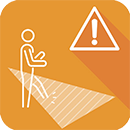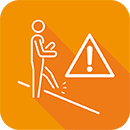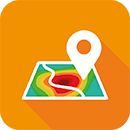AI Video Analysis Features for Enhanced Situational Awareness and Process Optimization
The cameras and recorders of the eneo IN series utilize Artificial Intelligence to convert video data into actionable information that enables immediate responses to security breaches and operational events.
AI-based video analysis offers advanced surveillance capabilities that surpass human limitations. Cameras with integrated AI features analyze video data in real time and with high accuracy, capable of recognizing objects and specific behaviors. Furthermore, AI-based video analysis functions differ from pixel-based video analysis by having a significantly lower false alarm rate and more efficient alarm processing. The eneo IN series devices come with a wide range of AI video analysis features that allow for extensive automation of monitoring and contribute to the optimization of operational processes.


License Plate Detection (LPD)
License plate detection produces usable images of license plates even in poor light and at various speeds.


License Plate Recognition (LPR)
The license plate recognition function segments and identifies the alphanumeric characters of license plates and converts them into text form. The captured license plates can be further processed, for example, in the license plate database of a parking management system. Often, license plate detection and recognition are combined to automatically identify and track vehicles. Hence, the AI cameras of the eneo IN series standardly come with both features.


Object Classification Human/Vehicle (PD&VD)
Based on AI-supported person and vehicle detection, users can define individualized alarm events. If the camera is equipped with integrated audio and siren functions, it can address or alert people in the monitoring area directly or automatically. This way, parking violations or entry into hazardous areas can be prevented, for example.


Face Recognition (FR)
The AI-based facial recognition feature enables efficient event research and evidence collection since users can specifically search the recordings for events involving certain individuals.


Facial Attribute Detection (AD)
The AI-based recognition of facial attributes captures age, gender, and other attributes of individuals in the monitoring area. With this data, users can generate statistics, for example, about the customer structure of a shop or specific areas on the sales floor.


Face Detection (FD)
The face detection feature filters single images or the video stream for faces. With this feature, users can quickly determine in which video sequences faces were recorded without having to assign them to a specific person. Unlike AI-based facial recognition, which assigns detected faces to individuals if the corresponding data is available, face detection merely recognizes the presence of faces, significantly shortening event research time and increasing its accuracy.


Face Attendance (FA)
The FA function is used to retrieve the status of face matches in various groups (except the "Strangers" group) that were stored over a specific period. This way, the presence of individuals at certain times in the monitoring area can be determined from the recordings, supporting users in verifying processes.


Stationary Objects (SOD):
The SOD function allows setting an alarm zone in the monitoring area. Leaving or removing an object in this zone automatically triggers a real-time alarm message or warning. This protects exhibits in showrooms, museums, or exhibition halls and increases security in public places and in local and long-distance public transport. Furthermore, the SOD function can be used to prevent obstructions of emergency exits and escape routes.


Intrusion (PID)
With intrusion detection, users can define a virtual perimeter in the monitoring area to detect potential threats as early as possible. The camera learns to distinguish between security-critical and harmless movement patterns. In case of an alarm event, for example, an automatic announcement can be made to people in the monitoring area.


Cross Counting (CC)
The AI-supported passage counting enables the exact counting of persons, vehicles, and arbitrary objects crossing a user-defined counting line in a specific direction. This can precisely capture the number of people present and the entries and exits in a room or building. Possible areas of application include shops, supermarkets, cinemas, museums, and event locations.


Line Crossing Detection (LCD)
When persons or vehicles cross a user-defined virtual boundary line, an alarm and/or recording is triggered. This function can support the prevention and investigation of crimes or complement physical/mechanical safeguards in accident prevention. Possible areas of application include object and perimeter protection, public transport, as well as production and logistics.


Crowd Density (CD)
With the Crowd-Density function (CD), the volume of people in the monitoring area is measured. An alarm is triggered when a critical number of people is reached. The CD function enables early detection of crowds or congestions and is suitable for use in stores, shopping centers, exhibition halls, or event locations.


Queue Detection (QD)
The QD function enables store managers to positively influence customer satisfaction. As soon as a queue in the monitoring area exceeds a defined length or waiting time, the responsible employees are notified. The AI-based queue detection is particularly interesting for retailers as itallows them to deploy staff based on demand and targeted needs, thus increasing customer satisfaction.


Heat Map (HM)
Heatmaps visualize the frequency of people in the monitoring area with an intuitive color scheme. Customer hotspots and less frequented areas on the sales floor become immediately apparent. The function can be used for planning advertising spaces and product placement, optimizing walkways, and improving the shopping experience.


Rare Sound Detection (RSD)
eneo AI cameras are equipped with an audio analysis function that detects unusual sounds such as gunshots, screaming babies, and barking dogs, thus extending the monitoring area with an acoustic dimension.
